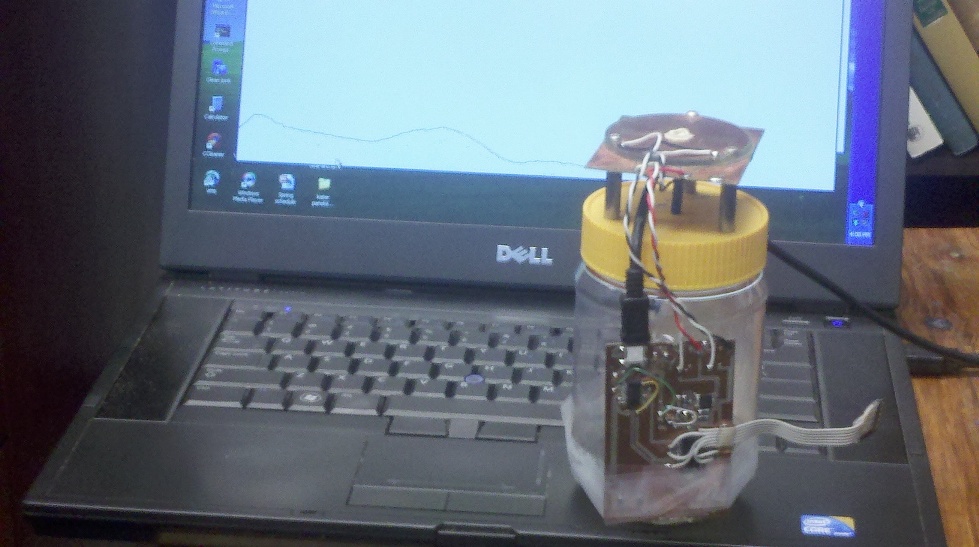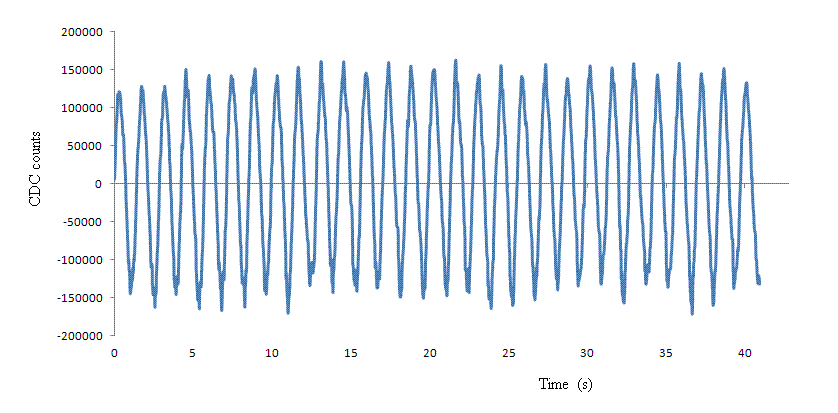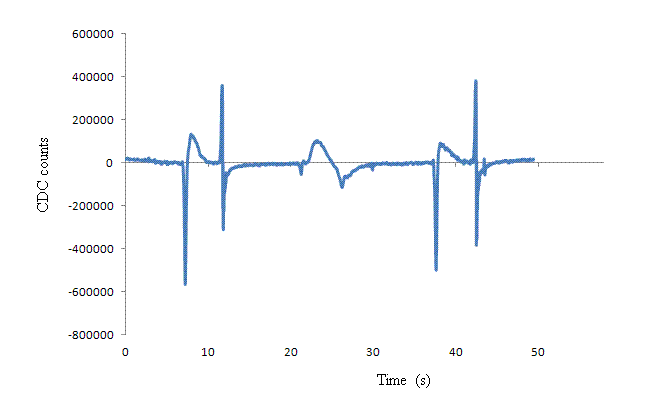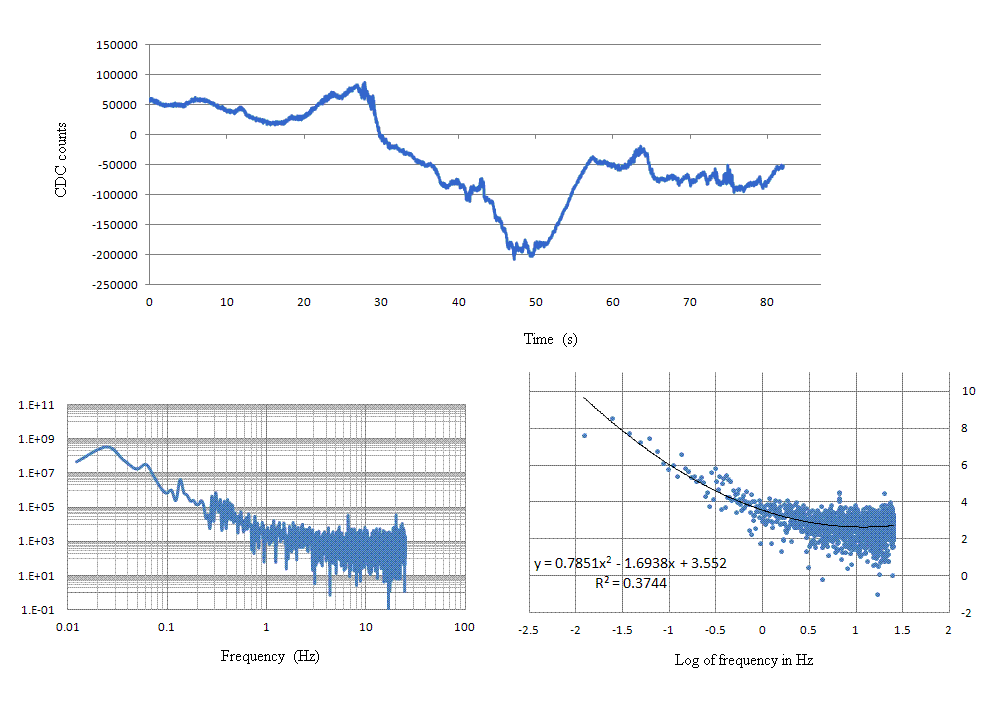
Figure 1. Ultra-sensitive differential pressure sensor attached to a bottle so as to function as a micro-barometer.
1Physics Department, and 2 School of Engineering, Mercer University, Macon, GA.
Copyright May 2012
An extremely sensitive differential pressure sensing device is described, that operates with an aluminized mylar diaphragm placed between electrodes to form a fully differential capacitive sensor. By associating the air space of one side of the diaphragm with a closed container, and letting the other side be open to the atmosphere, the unit functions as a micro-barometer. Its sensitivity is of the order of one part per ten million of standard atmospheric pressure.
Background
The patent owned by the first author of this article is one that includes fully differential capacitance transducer types that operate on the basis of (i) changes in gap spacing between electrode components as well as (ii) electrode area variations [1]. The former configuration is amenable to the fabrication of sensitive differential pressure sensors, such as the micro-barometer described here and pictured in Fig. 1.
Instrument

Figure 1. Ultra-sensitive differential pressure sensor attached to a bottle so as to function as a micro-barometer.
Shown taped to the bottle is the board holding the electronic support components, the heart of which is the Analog Devices AD7745 capacitance to digital converter chip. Power for the package is supplied by the computer through the USB cable.
Calibration
To calibrate the instrument, the bottle/sensor package was manually moved up and down along a vertical line in near simple harmonic manner through a peak to peak distance of 0.5 m. The digitally acquired and stored record that was thus obtained is shown in Fig. 2.

Figure 2. Results of a calibration based on atmospheric pressure change as a function of altitude.
Using the expression for atmospheric pressure change with altitude y; i.e., DP = r g Dy with assumed density of the atmosphere of 1.29 kg/m3 and acceleration of gravity g = 9.8 m/s2, the data of Fig. 2 yields a calibration constant for the instrument of 2.37 × 107 CDC counts / Pa.
Example applications
Because of its great sensitivity to changes in air pressure, the instrument can be used for a variety of novel and interesting purposes. Illustrated by Fig. 3 is the device's capability for functioning as an intrusion alarm.

Figure 3. Example of the instrument's potential application as an intrusion alarm.
There are three consecutive highly visible door opening pulse patterns observed in the digitally stored record of Fig. 3, that was graphed using Excel. The first and the last patterns were due to door opening/closing of the office in which the instrument was located at the time of data acquisition. The middle pattern was due to opening/closing of another office door displaced from the other door by a distance of about 10 m. The instrument is so sensitive that door openings to the outside of the building holding both offices can be observed!
Another obvious application for this mico-barometer is for novel studies of subtle changes of meteorological type. Because of the mobility of the laptop used with the instrument, it can be readily used to obtain historic records of the type shown in Fig. 4.

Figure 4. Example of potential application to novel experiments in meteorology.
In the spectra (lower plots) of Fig. 4, several distinct pressure oscillations are visible, such as at 0.13 Hz, 6.6 Hz, and 20 Hz. These were probably due to standing waves set up by wind blowing between the building and an adjacent hill. The sensor was located at the bottom of that hill. The abscissa of the lower left spectrum is one involving a log-scale of the frequency. To obtain information concerning the 1 / fx character of the noise, with x to be determined, one uses a log-frequency abscissa as shown in the lower right plot of the figure. A linear trendline fit to the data is not as good as the polynomial fit of oder 2 shown. That linear fit gave x = -0.8, implying pink noise; however, the quadratic fit suggests something between pink and brown (x = -2).
The authors have contemplated another possibly useful application, because of the following observation:
It was observed, before the Banda Aceh earthquake tsunami of Dec. 2004-that elephants moved to high ground before the arrival of the tsunami that killed so many. Perhaps instead of the elephants feeling the earthquake through seismic waves in the crust of the earth, they actually heard infrasonic (to a human) waves in the atmosphere, that arrived way before the tsunami. If so, then maybe this micro-barometer could also function as a tsunami detector. Only time will tell, through wide-scale deployment of the instrument should it happen.
Reference
[1]``Symmetric differential capacitance transducer employing cross coupled conductive plates to form equipotential pairs'', U. S. Patent 5,461,319. The predecessor LRDC sensor, also invented by Peters, was the first version of ``fully differential capacitive sensors'', which are becoming increasingly commonplace in engineering applications.